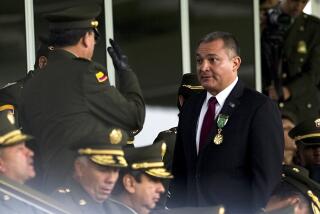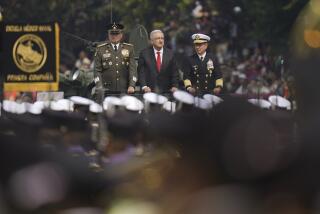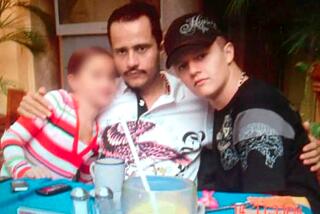Mexican Police Had Roles in Cocaine Trade, Witness Says : Trial: A shadowy figure who is now a government-paid informant claims state and federal agencies in Guadalajara were involved in trafficking in the 1980s.
- Share via
A prosecution witness in the Enrique Camarena murder trial testified in Los Angeles Wednesday that officials of several Mexican government agencies in Guadalajara were enmeshed in drug trafficking in the early and mid-1980s.
The testimony in U.S. District Court was given by Victor Lorenzo Harrison, a shadowy figure who is now a government-paid informant.
Harrison, 50, said that he had set up radio communications systems for both federal and state police agencies in Mexico and that he had created and installed sophisticated radio systems for Ernesto Fonseca Carrillo and Rafael Caro Quintero, two of Mexico’s leading drug traffickers. Both men currently are serving prison terms in Mexico for their involvement in the 1985 torture and murder of Camarena, a U.S. Drug Enforcement Administration agent who had been probing their narcotics operations in Guadalajara.
Four men are currently on trial here, charged with involvement in Camarena’s murder.
Harrison presented perhaps the most lurid picture yet in the four-week trial of the interrelationship between drug lords and Mexican law enforcement officials.
He said that Fonseca and many of his assistants had credentials from one or more of Mexico’s law enforcement agencies and that other leading traffickers and their henchmen had police credentials as well. He also said that he had once seen traffickers use a Mexican police credential to snort cocaine at a party at Fonseca’s house.
Harrison said that he had lived at Fonseca’s house for several months in 1983 and 1984 and that he had seen major drug traffickers visit the house for meetings. He said that law enforcement personnel frequently attended parties at Fonseca’s house.
Under questioning by defense attorney Edward Medvene, Harrison admitted that he never saw defendant Ruben Zuno Arce at any of those meetings.
However, the 6-foot 7-inch witness said that he saw Zuno embrace Caro at a Guadalajara party in 1983 and added that Caro, who had been riding on a specially trained dancing horse at the party and smoking a “cocaine-base cigarette,” got off the horse and embraced Zuno. Zuno has denied knowing Caro.
On cross-examination, Medvene asked Harrison if he had ever reported to Mexican law enforcement officials that he had seen Zuno and Caro embracing. “I wouldn’t know who to report it to,” Harrison responded.
Medvene then asked Harrison: “Are you saying everyone in Mexico is corrupt?”
“Everyone I met and everyone I saw,” the witness responded. “. . . The law enforcement apparatus and the army apparatus were all together in this (drug trafficking) operation.”
Harrison said that he had decided to become a government witness last September after he had received several overtures from a Mexican government official whose name he declined to state. Harrison said the official had been asked to approach him by Antonio Garate Bustamante, a veteran DEA operative, who recently has been enmeshed in controversy as the architect of the April 2 kidnaping of a Mexican doctor who has been indicted in the Camarena case.
Harrison said he had known Garate since 1981. At that time, Harrison said, he installed an electronic system at Garate’s Guadalajara home when Garate headed the Guadalajara police SWAT team. Later, Harrison testified, at Garate’s request he had helped set up a radio communications system to aid Colombian planes land in Mexico. U.S. government documents state that these planes were used for drug smuggling.
The witness said it had been a very difficult decision for him to become a government witness because he feared that he might be killed. Earlier in his testimony, Harrison said he had been shot nine times in 1984 by Mexican law enforcement officials and then imprisoned on several charges, including robbery and extortion. He was released in 1985.
Harrison has been granted immunity from prosecution for his testimony and his family has been relocated to the United States for security reasons, according to U.S. documents. Between September, 1989, and February, 1990, the DEA paid him $18,000 for information and expenses and it is believed the payments are continuing.
Harrison acknowledged that he had used three other names in his life. He said he first changed his name about 25 years ago when he was auditing classes at UC Berkeley and its law school at the height of the anti-war movement.
He said he could not remember how he got to the United States last September. Later, outside the presence of the jury, Harrison said he feared revealing the names of the people who helped him get out of Mexico.
“They surely would be killed if I gave their names,” he said. U.S. District Judge Edward Rafeedie said that cross-examination of Harrison could resume today and that he would have to tell how he got to this country, but the judge reserved a decision on whether Harrison would have to divulge the names of those who helped him.
Earlier in the day, a Navy doctor who performed an autopsy on Camarena gave grisly testimony, saying it appeared that the agent’s killers had pushed a blunt instrument, perhaps a Phillips-head screwdriver, through his head.
Dr. Jerry Douglas Spencer said that when he examined Camarena in a Guadalajara hospital in on March 7, 1985, there was a substantial hole in his skull, fractures to his jaw and eight broken ribs.
More to Read
Sign up for Essential California
The most important California stories and recommendations in your inbox every morning.
You may occasionally receive promotional content from the Los Angeles Times.










